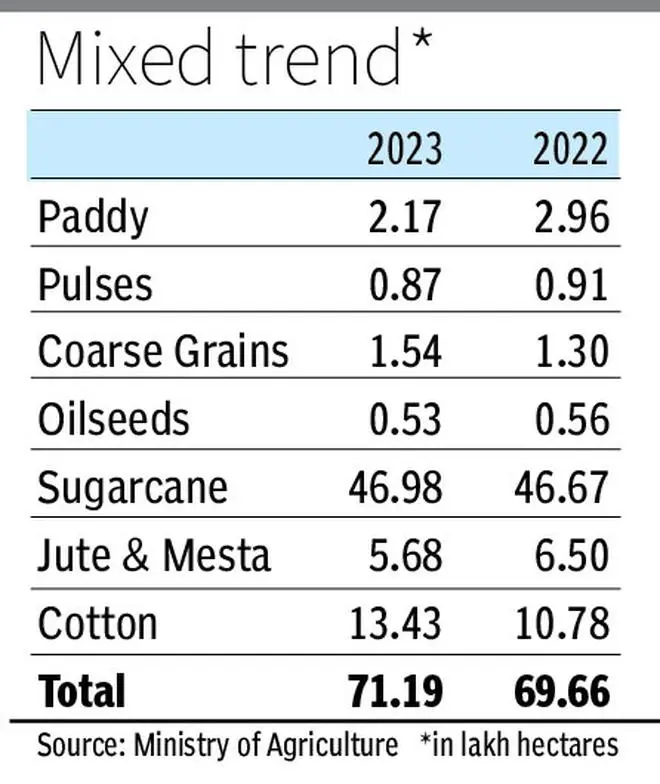Paddy, pulses and oilseeds sowing trailed as planting activities of kharif crops gather pace, while the area under sugarcane, cotton and coarse cereals was higher as of Friday, data from the Agriculture Ministry showed.
Kharif sowing activities this year have been aided by higher rainfall in May. According to the India Meteorological Department (IMD), the rainfall was 10 per cent higher than the long period average based on 1971-2020 data. IMD said the rainfall of 67.3 mm was the third-highest since 1901 with the other two being 95 mm in 1987 and 68.2 mm in 2021.

Arhar, urad area up
Paddy has been sown on 2.17 lakh hectares (lh) against 2.96 lh during the same period a year ago. So far, the highest coverage has been reported from Nagaland followed by Assam and West Bengal. Sowing operations are yet to begin in Punjab, Haryana, Telangana and other key States.
The coverage of pulses was down at 0.87 lh against 0.91 lh a year ago. Of this, Karnataka has accounted for 0.63 lh with Uttar Pradesh accounting for another 0.14 lh.
Arhar (pigeon pea) and urad (black matpe) sowing seem to be gaining in view of prevailing higher prices, while the area under moong and other pulses is trailing.
Sesame a drag
Oilseeds acreage trailed at 0.53 lh against 0.56 lh a year ago with sesame being the main drag (0.08 lh vs 0.13 lh). The coverage of soyabean and groundnut looks like gaining, while that of sunflower lags behind.
Karnataka (0.26 lh) and Nagaland (0.19 lh) are the two States which have taken the lead in oilseed sowing with farmers in other key growing States such as Madhya Pradesh, Maharashtra and Rajasthan expected to begin the coverage once the monsoon sets in.
The IMD has said the south-west monsoon will be delayed this year and could set in after June 4. Currently, the monsoon is over Sri Lanka and has grazed Minicoy in Lakshadweep.
Encouraging factors
Maize and bajra lead the kharif coarse-cereals coverage, which is 1.5 lh against 1.3 lh a year ago. Jammu and Kashmir, Uttar Pradesh and Karnataka are the three States which have contributed much to the progress in sowing till now.
The coverage of sugarcane and cotton, as expected, is higher this year. Encouragement for farmers to plant more sugarcane comes from the sugar mills clearing the dues for supply of the cane on time. So far, sugarcane has been planted on 46.98 lh against 46.67 lh last year.
Uttar Pradesh and Maharashtra lead the coverage, making up nearly three-fourths of the area sown so far.
Cotton growers have drawn solace from prices ruling well above the minimum support prices in the last two seasons. Coverage of the natural fibre crop is up at 13.43 lh compared with 10.78 lh a year ago.
At least 12.5 lh of the acreage in cotton has almost been made up by Haryana, Rajasthan and Punjab.
Storage lower y-o-y
According to IMD, North-West India — the key to kharif crops production — received 94 per cent excess rainfall in May, while Central India, another key region, received 64 per cent more rains.
As a result of the excess rainfall, the total live storage in the 146 major reservoirs is 178.185 billion cubic metres (BCM) or 69.11 per cent of the total capacity of 257.812 BCM. The storage is 6 percentage points lower than the same time a year ago but 21 percentage points higher than the last 10 years average.




Comments
Comments have to be in English, and in full sentences. They cannot be abusive or personal. Please abide by our community guidelines for posting your comments.
We have migrated to a new commenting platform. If you are already a registered user of TheHindu Businessline and logged in, you may continue to engage with our articles. If you do not have an account please register and login to post comments. Users can access their older comments by logging into their accounts on Vuukle.